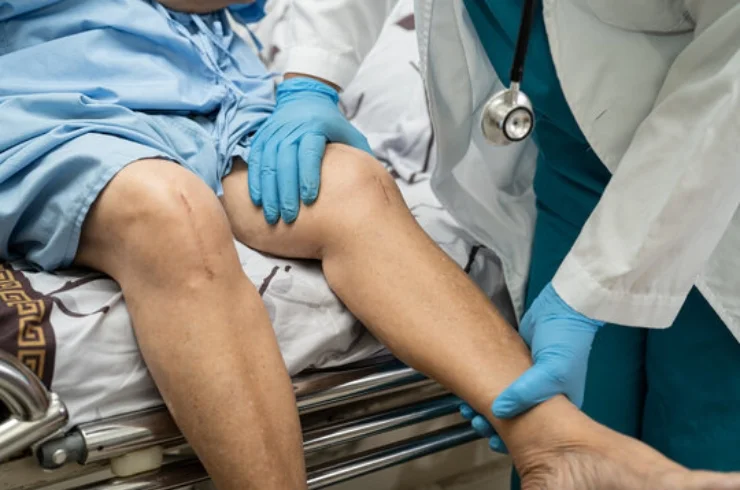Knee Replacement

Knee Replacement: Restoring Mobility and Relieving Pain
Overview
Knee replacement surgery, also known as knee arthroplasty, is a highly effective procedure designed to relieve pain, restore function, and improve the quality of life for individuals suffering from knee joint arthritis, severe fractures, or other degenerative knee conditions. The surgery involves removing the damaged or diseased parts of the knee joint and replacing them with an artificial implant, usually made of metal, plastic, and sometimes ceramic components. Knee replacement is commonly performed in individuals who have not responded to non-surgical treatments such as medications, physical therapy, or injections.
Indications for Knee Replacement
The most common reasons for knee replacement surgery include:
Osteoarthritis: The most frequent cause of knee replacement, where the cartilage in the knee joint wears away, leading to pain, stiffness, and loss of function.
Rheumatoid Arthritis: An autoimmune condition that causes inflammation of the knee joint, leading to joint destruction and pain.
Post-Traumatic Arthritis: Damage to the knee joint caused by previous injuries, such as fractures or ligament tears, that can lead to arthritis and joint degeneration.
Severe Fractures: In cases of complex knee fractures that cannot be repaired with other surgical methods, knee replacement may be necessary to restore function.
Deformities: Some individuals are born with knee deformities that can lead to arthritis and may require knee replacement later in life.
Types of Knee Replacement
Total Knee Replacement (TKR): In this procedure, the entire knee joint (including the femur, tibia, and patella) is replaced with a prosthesis. It is the most common type of knee replacement surgery.
Partial Knee Replacement (PKR): Also known as a unicompartmental knee replacement, only the damaged part of the knee joint is replaced, sparing the healthy tissue. It is an option for patients with arthritis limited to one part of the knee.
Kneecap Replacement (Patellofemoral Arthroplasty): This involves replacing only the damaged kneecap and the part of the femur that comes into contact with it. It is typically recommended for patients with isolated knee cap arthritis.
Procedure
Knee replacement surgery is typically performed under general or regional anesthesia. The procedure involves the following steps:
Removal of Damaged Tissue: The surgeon makes an incision over the knee and removes the damaged cartilage and bone from the femur, tibia, and sometimes the patella (kneecap). The surgeon may also reshape the remaining bone to ensure the new prosthesis fits securely.
Insertion of Prosthetic Components: The surgeon then inserts the metal or ceramic components that mimic the natural motion of the knee joint. The femoral component is attached to the thigh bone, the tibial component is placed on the shin bone, and a plastic spacer is inserted between them to allow smooth movement.
Alignment and Testing: After the components are in place, the surgeon tests the knee’s range of motion and alignment to ensure optimal function and stability.
Closing Incision: Once the components are properly positioned, the incision is closed with sutures, and a sterile bandage is applied.
Recovery and Rehabilitation
Post-surgery, patients typically stay in the hospital for 1 to 3 days. Immediate post-operative care includes pain management and physical therapy to help restore movement and strength. Most patients are encouraged to start walking with the assistance of a walker or crutches within a day or two to prevent stiffness and promote circulation.
Full recovery from knee replacement surgery takes about 6 to 12 weeks, though it can take up to 6 months for complete healing and the regaining of full function. Physical therapy is crucial to the rehabilitation process, helping patients regain strength, flexibility, and the ability to perform daily activities such as walking, climbing stairs, and getting in and out of chairs. By the end of the recovery period, most individuals can return to regular activities with reduced pain and improved mobility.
Benefits of Knee Replacement
Pain Relief: The primary benefit of knee replacement surgery is the significant reduction or complete elimination of pain caused by arthritis or injury.
Improved Function and Mobility: Knee replacement restores joint function, allowing patients to return to normal daily activities, such as walking, exercising, and participating in hobbies.
Enhanced Quality of Life: The reduction in pain and improvement in mobility lead to a better quality of life, with many patients experiencing increased independence and confidence.
Risks and Complications
While knee replacement is generally a safe and effective procedure, it carries some risks, including:
- Infection
- Blood clots
- Nerve or blood vessel damage
- Implant loosening or wear over time
- Stiffness or limited range of motion
However, these complications are relatively rare, and the success rate for knee replacement is very high.
Conclusion
Knee replacement surgery is a transformative procedure that provides lasting relief from knee pain, restores function, and improves the quality of life for individuals suffering from severe knee joint issues. With advancements in surgical techniques and prosthetic designs, knee replacement has become one of the most successful and commonly performed orthopedic procedures. Most patients who undergo knee replacement can expect significant improvement in their mobility and an overall enhancement of their daily lives.
